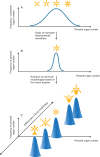The significance of developmental robustness for species diversity
- PMID: 26994100
- PMCID: PMC4845805
- DOI: 10.1093/aob/mcw018
The significance of developmental robustness for species diversity
Abstract
Background: The origin of new species and of new forms is one of the fundamental characteristics of evolution. However, the mechanisms that govern the diversity and disparity of lineages remain poorly understood. Particularly unclear are the reasons why some taxa are vastly more species-rich than others and the manner in which species diversity and morphological disparity are interrelated.
Scope and conclusions: Evolutionary innovations and ecological opportunities are usually cited as among the major factors promoting the evolution of species diversity. In many cases it is likely that these factors are positively reinforcing, with evolutionary innovations creating ecological opportunities that in turn foster the origin of new innovations. However, we propose that a third factor, developmental robustness, is very often essential for this reinforcement to be effective. Evolutionary innovations need to be stably and robustly integrated into the developmental genetic programme of an organism to be a suitable substrate for selection to 'explore' ecological opportunities and morphological 'design' space (morphospace). In particular, we propose that developmental robustness of the bauplan is often a prerequisite for the exploration of morphospace and to enable the evolution of further novelties built upon this bauplan Thus, while robustness may reduce the morphological disparity at one level, it may be the basis for increased morphological disparity and for evolutionary innovations at another level, thus fostering species diversity.
Keywords: basal angiosperm; biodiversity; developmental robustness; disparity; diversity; ecological opportunity; evolutionary innovation; flower development; insect; orchid; plasticity; speciation.
© The Author 2016. Published by Oxford University Press on behalf of the Annals of Botany Company. All rights reserved. For Permissions, please email: journals.permissions@oup.com.
Figures


Similar articles
-
Species diversity vs. morphological disparity in the light of evolutionary developmental biology.Ann Bot. 2016 Apr;117(5):781-94. doi: 10.1093/aob/mcv134. Epub 2015 Sep 7. Ann Bot. 2016. PMID: 26346718 Free PMC article. Review.
-
Why should we investigate the morphological disparity of plant clades?Ann Bot. 2016 Apr;117(5):859-79. doi: 10.1093/aob/mcv135. Epub 2015 Dec 9. Ann Bot. 2016. PMID: 26658292 Free PMC article.
-
Evolution of unusual morphologies in Lentibulariaceae (bladderworts and allies) and Podostemaceae (river-weeds): a pictorial report at the interface of developmental biology and morphological diversification.Ann Bot. 2016 Apr;117(5):811-32. doi: 10.1093/aob/mcv172. Epub 2015 Nov 20. Ann Bot. 2016. PMID: 26589968 Free PMC article. Review.
-
Global patterns and a latitudinal gradient of flower disparity: perspectives from the angiosperm order Ericales.New Phytol. 2021 Apr;230(2):821-831. doi: 10.1111/nph.17195. Epub 2021 Mar 4. New Phytol. 2021. PMID: 33454991 Free PMC article.
-
Why does pollen morphology vary? Evolutionary dynamics and morphospace occupation in the largest angiosperm order (Asterales).New Phytol. 2022 May;234(3):1075-1087. doi: 10.1111/nph.18024. Epub 2022 Mar 3. New Phytol. 2022. PMID: 35147224
Cited by
-
Studying evolution of the primary body axis in vivo and in vitro.Elife. 2021 Aug 31;10:e69066. doi: 10.7554/eLife.69066. Elife. 2021. PMID: 34463611 Free PMC article. Review.
-
Resurrected Protein Interaction Networks Reveal the Innovation Potential of Ancient Whole-Genome Duplication.Plant Cell. 2018 Nov;30(11):2741-2760. doi: 10.1105/tpc.18.00409. Epub 2018 Oct 17. Plant Cell. 2018. PMID: 30333148 Free PMC article.
References
-
- Ackerman JD, Morales M, Tremblay RL. 2011. Darwin’s orchids: their variation, plasticity, and natural selection. Lankesteriana, 11: 6.
-
- Adamic L. 2011. Unzipping Zipf’s law. Nature 474: 164–165. - PubMed
-
- Baek SK, Bernhardsson S, Minnhagen P. 2011. Zipf’s law unzipped. New Journal of Physics 13: 043004.
MeSH terms
LinkOut - more resources
Full Text Sources
Other Literature Sources


